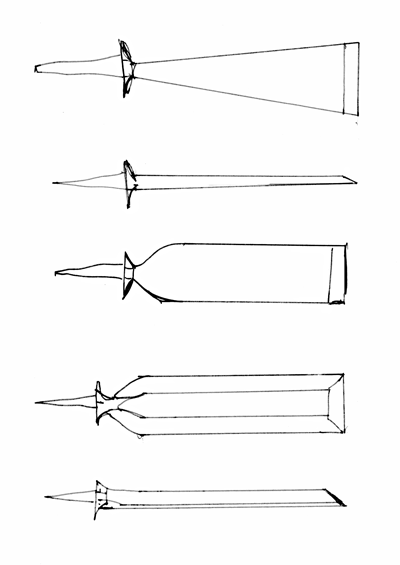|
|
07/27/2009 (the first part of an eventual series on how the modern chisel developed) |
 The earliest European chisels were fishtail in shape. Really to get the term exactly correct - "Alongee pattern" is the correct term - where the body of the chisel flares out from the bolster. In China they still make them like this (see top two drawings). The earliest European chisels were fishtail in shape. Really to get the term exactly correct - "Alongee pattern" is the correct term - where the body of the chisel flares out from the bolster. In China they still make them like this (see top two drawings).
The thickness of these chisels starts out pretty fat and then tapers to very thin at the cutting edge. Size was very nominal. The body of these chisels would be wrought iron with either a steel cutting edge forge welded on like they still do in Japan, or maybe just even caseharded. Between the thinness at the cutting edge and the fishtail shape, this style of chisel was great for joinery. Except as the chisel wears and gets shorter it also get narrower and worse; thicker. This was a real issue back then. Unlike today where a chisel is almost a finishing tool, chisels in the pre-industrial age were work horses. All joints were cut with saws and chisels and a joiner or cabinetmaker would use their tools constantly. The reason why so few chisels survive from this period is that they were used up. Most accounts of joiner's careers at the time mention wear and tear on tools as a major cost.
Narrower is annoying - you paid for a 1" chisel and now you need to get another one. Thicker is much worse - it makes it much harder to do joinery as the sides of the chisel get too thick to fit in thin places.
Then something happened. Well two things. The first is that instead of maintaining the flare, the chisels in the 18th century become almost parallel with just a little flare. This is progress as you wear the chisel it gets shorter but it doesn't get particularly narrower (see the second and third drawing from the top).
With this style of chisel - even if it stayed the same width you would have to replace it after a small amount of usage to get back to the thin section needed for joinery.
Then came the second innovation: Grinding side bevels. Up until World War Two the side bevels of a chisel would have been hand ground - which is a real skill to do consistently. But it made for a constant thickness chisel - which could be used all the way up with no loss of function. This was a big step forward and after 1850 or so the earlier style of chisel disappears and we have the modern beveled edge bench chisel (bottom two drawings).
I would like to relate the appearance of side bevels to the expansion of the capacity of toolmakers to grind using steam power. But I can't. The reason for the innovations are pretty clear, if not actually documented in contemporary literature but the how, if there was a specific inventor, or technology change that triggered the change is unknown to me. It's a question wide open for research.
There are also interesting developments in handle design and bolsters and ferrules and sockets and tangs - which I will save for another time.
|
Join the conversation |
|
 Joel's Blog
Joel's Blog Built-It Blog
Built-It Blog Video Roundup
Video Roundup Classes & Events
Classes & Events Work Magazine
Work Magazine


 The earliest European chisels were fishtail in shape. Really to get the term exactly correct - "Alongee pattern" is the correct term - where the body of the chisel flares out from the bolster. In China they still make them like this (see top two drawings).
The earliest European chisels were fishtail in shape. Really to get the term exactly correct - "Alongee pattern" is the correct term - where the body of the chisel flares out from the bolster. In China they still make them like this (see top two drawings).
Stephen
Those examples would be the exception rather than the rule.
JH